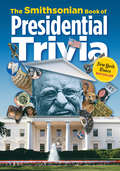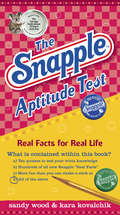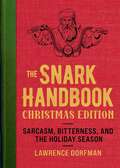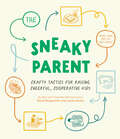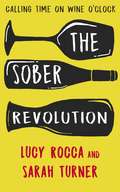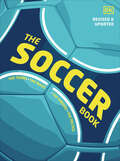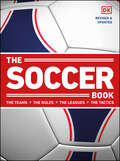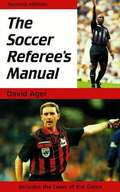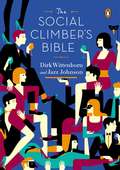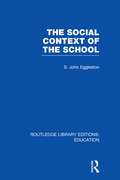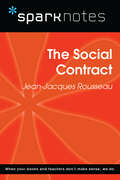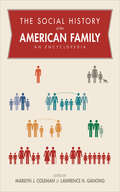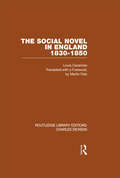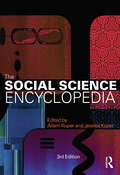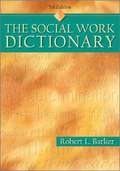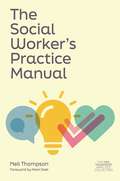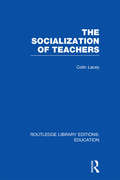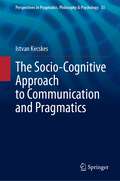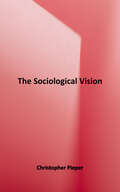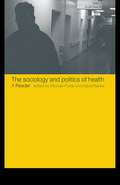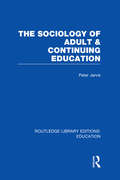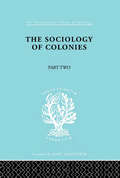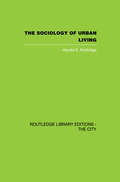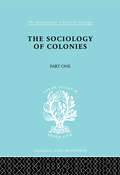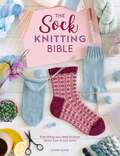- Table View
- List View
The Smithsonian Book of Presidential Trivia
by Amy Pastan Smithsonian InstitutionWhich president holds the record for the most vetoes? Which president had the largest shoe size? Who was the only president to serve in both World War I and World War II? Who was the tallest president? These questions and many, many more are answered in The Smithsonian Book of Presidential Trivia.Divided into 11 chapters, The Smithsonian Book of Presidential Trivia looks at every aspect of our heads of state and presidential history: Citizens, Officers, Heroes, and Saviors; Stumping: From Front Porch to Facebook; The Pledge and the Parties; Inside the Oval Office; The Perpetual Podium; Home, Hotel, Parlor, Playground; First Families; Impeachment, Controversy, Shame; Assassination; Death, and National Mourning; Presidents in the Popular Imagination; and The Quotable President.Many of the questions are accompanied with photographs of artifacts from the Smithsonian's collections. The Smithsonian Book of Presidential Trivia is sure to puzzle the trivia buff and presidential expert alike!
The Snapple Aptitude Test: Real Facts for Real Life
by Sandy Wood Kara KovalchikSnapple's "Real Facts" have appeared on more than one billion Snapple caps since the initiative began in 2001. Now, two trivia experts have culled the very best and added a host of other trivia to create The Snapple Aptitude Test. Featuring one thousand questions, it challenges readers to test their knowledge of history, geography, science, pop culture, sports, health, literature, and technology. And when the pencils go down, the scoring begins. Achieve 1,000-point perfection and be forever known as a “Real Genius.”
The Snark Handbook: Sarcasm, Bitterness, and the Holiday Season (Snark Series)
by Lawrence DorfmanBah! Humbug! It&’s that time of year again….Time to spend too much, drink too much, eat too much, smile falsely, dig down deep to try and find &“good cheer,&” battle crowds, try to find parking in over-crowded lots, ignore surly clerks, bartenders, waiters, valets, and parking lot attendants, all in the pursuit of that moment of happiness known throughout the world as…dun, dun, dun: the Holidays. Has there ever been a time more suited to tapping into snark? With commentary, jokes, and quotes regarding Thanksgiving, Christmas, Hanukkah, Kwanza, New Year&’s; on bad presents, worse in-laws, horrible children, and much more glorious excess. Enjoy such rotten sugar plums as: • &“Santa Claus has the right idea. Visit people once a year.&”—Victor Borge • &“If someone screws up on their gift, there are seven more days to correct it...No awkward explanations of virgin birth...No Irving Berlin songs.&”—Among the Top Ten Reasons to Love Hanukkah • &“What I don&’t like about office Christmas parties is looking for a job the next day.&”—Phyllis DillerThe Snark Handbook: Christmas Edition is destined to be a holiday classic.
The Sneaky Parent: Crafty Tactics for Raising Cheerful, Cooperative Kids
by David Borgenicht James GraceMore than 200 clever tips to help stubborn kids go to bed, clean their room, take a bath, and more—without tears or fights.As a parent, you want nothing more than to keep your child fed, clothed, clean, healthy, and safe. Your kid, meanwhile, wants nothing more than to eat junk, go nude, stay up all night, and fall down a well. Begging doesn&’t work. Bribery isn&’t sustainable. You don&’t want to shout. It&’s time to get sneaky.The Sneaky Parent offers a full playbook of clever ploys for beating kids at their own game. With the strategies outlined in this book, you can gently guide kids toward positive choices—while letting them think they&’re the ones in control. Learn how to: Boost oral hygiene by pretending a toothbrush is a paintbrush for teethRender long plane trips painless with a game of &“Name That Cloud&”Calm separation anxiety by developing fun ways to wave goodbyeAnd dozens of other clever tactics, tricks, and gamesWith a little benevolent sneakiness, your child will enthusiastically try new foods, embrace bath time, go to sleep on a schedule, and other necessary but unpopular life skills. The best part? They&’ll be sure it was their idea.Previously published as How to Con Your Kid (2012) this edition includes gender-neutral language, updated screen time advice, and more for today's parent.
The Sober Revolution: Calling Time on Wine O'Clock
by Lucy RoccaDo you count down the minutes to wine o'clock on a daily basis? Is a bottle of Pinot Grigio your friend at the end of a long hard day? If you want to give up being controlled and defined by alcohol then now is the time to join The Sober Revolution... Fed up of living in a fog of hangovers, lethargy and guilt from too much wine? Have you tried to cut down without success? You are not alone. When it comes to alcohol, millions of people around the world find it hard to exercise moderation and become stuck in a vicious cycle of blame, guilt and using more alcohol as a way of coping. The Sober Revolution looks at women and their relationships with alcohol, exploring the myths behind this socially acceptable yet often destructive habit. Rather than continuing the sad spiral into addiction it helps women regain control of their drinking and live happier, healthier lives. Sarah Turner, cognitive behavioural therapist and addictions counsellor, and Lucy Rocca, founder of Soberistas.com, the popular social networking site for women who have successfully kicked the booze or would like to, give an insight into ways to find a route out of the world of wine. The Sober Revolution will open your eyes to the dangers of social drinking and give you the tools you need to have a happy life without the wine. Read it now and call time on wine o'clock forever.
The Soccer Book
by DKWhether you want to bend it like Beckham or dribble like Ronaldinho, The Soccer Book is the ultimate visual guide to soccer skills, rules, tactics, and coaching, illustrating every aspect of every variant of the sport more clearly, and in more detail, than any other book has done before.
The Soccer Book: The Teams, the Rules, the Leagues, the Tactics (DK Sports Guides)
by DKWhether you want to bend it like Beckham or dribble like Ronaldinho, The Soccer Book is the ultimate visual guide to soccer skills, rules, tactics, and coaching, illustrating every aspect of every variant of the sport more clearly, and in more detail, than any other book has done before.
The Soccer Referee's Manual
by David AgerThis widely respected book has been revised to ensure that it continues to deliver the latest instruction on soccer refereeing and includes: FIFA's (soccer's worldwide governing body) most recent amendments to the Laws of the Game Expectations on how referees administer the laws and control play; Expert advice and insights into the FA's referee training; Over 100 questions and answers on the laws and their interpretation. Written by an acknowledged authority, "The Soccer Referee's Manual" is an invaluable reference for referees and for fans who want to improve their understanding of soccer.
The Social Climber's Bible
by Dirk Wittenborn Jazz JohnsonWelcome fledging Social Climbers! Allow us to show you the way. Birds do it, bees do it, even educated fleas do it, so what's the big deal? You shouldn't be punished for wanting to improve your lot in life! This is America, after all. Johnson & Johnson heiress Jazz Johnson is a lifelong insider in that rarefied world that fans of both Downton Abbey and Gossip Girl dream about. Raconteur Dirk Wittenborn is old enough to remember when sex was safe and cocaine wasn't addictive. In short, Jazz belongs to some of the most exclusive clubs in the world, whereas Dirk has been kicked out of them. Who better to guide you? In the grand tradition of True Prep and The Hipster Handbook, The Social Climber's Bible will teach you everything you need to know to become a pro Mountaineer: The Art of Social Climbing at gallery openings, cocktail parties, and funerals Social Climbing as a family How to handle sex, dating, marriage, and love Your social climbing IQ and how to improve it How to spot a Big Fish, Whale, Turtle or Unicorn, and what they can do for you
The Social Context of the School (Routledge Library Editions: Education)
by John EgglestonIn their appearance, schools often seem to be physically separated from their surroundings, cut off from the neighbouring houses and streets by high walls, by playgrounds or playing fields. Within the school, another world seems to exist, with a life of its own – its own routine, dress, rules and customs – which appears to have little relationship to the day-to-day life of the society outside. Yet despite these signs of separateness, we are becoming increasingly aware that a school’s surroundings, the local society in which it is set and whose children it educates, play an important part in determining what actually goes on in the classrooms and the playgrounds. This book looks at some of the factors in the local context of the schools and describes and analyses some of the often complex ways in which the schools interact with them.
The Social Contract (SparkNotes Philosophy Guide)
by SparkNotesThe Social Contract (SparkNotes Philosophy Guide) Making the reading experience fun! SparkNotes Philosophy Guides are one-stop guides to the great works of philosophy–masterpieces that stand at the foundations of Western thought. Inside each Philosophy Guide you&’ll find insightful overviews of great philosophical works of the Western world.
The Social History of the American Family: An Encyclopedia
by Professor Marilyn Coleman Lawrence H. GanongThe American family has come a long way from the days of the idealized family portrayed in iconic television shows of the 1950s and 1960s. The four volumes of The Social History of the American Family explore the vital role of the family as the fundamental social unit across the span of American history. Experiences of family life shape so much of an individual’s development and identity, yet the patterns of family structure, family life, and family transition vary across time, space, and socioeconomic contexts. Both the definition of who or what counts as family and representations of the “ideal” family have changed over time to reflect changing mores, changing living standards and lifestyles, and increased levels of social heterogeneity. Available in both digital and print formats, this carefully balanced academic work chronicles the social, cultural, economic, and political aspects of American families from the colonial period to the present. Key themes include families and culture (including mass media), families and religion, families and the economy, families and social issues, families and social stratification and conflict, family structures (including marriage and divorce, gender roles, parenting and children, and mixed and non-modal family forms), and family law and policy. Features: Approximately 600 articles, richly illustrated with historical photographs and color photos in the digital edition, provide historical context for students. A collection of primary source documents demonstrate themes across time. The signed articles, with cross references and Further Readings, are accompanied by a Reader’s Guide, Chronology of American Families, Resource Guide, Glossary, and thorough index. The Social History of the American Family is an ideal reference for students and researchers who want to explore political and social debates about the importance of the family and its evolving constructions.
The Social Novel in England 1830-1850: Routledge Library Editions: Charles Dickens Volume 2 (Routledge Library Editions: Charles Dickens #Vol. 2)
by Louis CazamianThis is the first English translation of Le Roman social en Angleterre by Louis Cazamian, which is widely recognized as the classic survey of Victorian social fiction. Starting from the eighteenth century, Cazamian traces the ways in which rationalism and romanticism intertwined and competed, particularly in relation to radical political philosophy. He shows how industrialization polarized England, setting the industrial bourgeoisie in the van of progress in the first decades of the nineteenth century, until their political and economic triumph stirred up a passionate reaction against them. This reaction propelled novelists such as Charles Dickens who lies at the centre of his discussion. For this translation Martin Fido has provided a substantial foreword, and has revised and completed the bibliographical references and corrected the footnotes to assist the present-day reader.
The Social Science Encyclopedia
by Adam Kuper Jessica KuperThe Social Science Encyclopedia, first published in 1985 to acclaim from social scientists, librarians and students, was thoroughly revised in 1996, when reviewers began to describe it as a classic. This third edition has been radically recast. Over half the entries are new or have been entirely rewritten, and most of the balance have been substantially revised.Written by an international team of contributors, the Encyclopedia offers a global perspective on key issues within the social sciences. Some 500 entries cover a variety of enduring and newly vital areas of study and research methods. Experts review theoretical debates from neo-evolutionism and rational choice theory to poststructuralism, and address the great questions that cut across the social sciences. What is the influence of genes on behaviour? What is the nature of consciousness and cognition? What are the causes of poverty and wealth? What are the roots of conflict, wars, revolutions and genocidal violence?This authoritative reference work is aimed at anyone with a serious interest in contemporary academic thinking about the individual in society.
The Social Work Dictionary (5th Edition)
by Robert L. BarkerProvides the social worker with an abbreviated interpretation of the words, concepts, organizations, historical events, and values that are relevant to the profession. Covers some 8,000 terms, including 2,000 that are new to this edition. Other features include a list of frequently-used acronyms; a list of milestones in the development of social work and social welfare; the NASW Code of Ethics; and resources. Annotation copyrighted by Book News, Inc., Portland, OR.
The Social Worker's Practice Manual (The Neil Thompson Practice Collection)
by Neil ThompsonAn essential handbook for students and experienced social workers alike, this practical guide filters out the jargon and sets out what you really need to know. 30 easy-to-follow chapters delve into topics ranging from holistic thinking to effective record keeping, all rooted in Neil Thompson's extensive hands-on experience. Complicated subjects such as cultural sensitivity and managing conflict are discussed thoughtfully and pragmatically, helping you understand the roots of tricky situations and find effective solutions. Each section successfully combines theory and practice to give a holistic view of social work that can be tailored to help each unique client. Over 45 years of experience distilled into one manual for success.
The Socialization of Teachers (Routledge Library Editions: Education)
by Colin LaceyThe change from a student role to a teacher role can be one of the most abrupt and stressful transitions in working life but the process of socialization does not end when the student becomes a fully qualified teacher, as many writers, laymen and sociologists, would have us believe. Colin Lacey argues that socialization is a partial and rarely homogenous process. He illustrates this from a wide variety of interesting case material to show how student teachers adapt their responses to the classroom situation.
The Socio-Cognitive Approach to Communication and Pragmatics (Perspectives in Pragmatics, Philosophy & Psychology #33)
by Istvan KecskesThe book aims to serve as a theoretical framework for the socio-cognitive approach (SCA) that is an alternative to the two main lines of pragmatics research: linguistic-philosophical pragmatics and sociocultural-interactional pragmatics. SCA broadens the scope of the field with an intent to incorporate not only L1 communication but also intercultural communication, and communication in a second language. The author integrates the pragmatic view of cooperation and the cognitive view of egocentrism and emphasizes that both cooperation and egocentrism are manifested in all phases of communication, albeit to varying extents. SCA places equal importance on the social and cognitive individual factors in pragmatics. The author claims that while (social) cooperation is an intention-directed practice that is governed by relevance, (individual) egocentrism is an attention-oriented trait dominated by salience.The book serves as a theoretical guide for researchers and students who would like to understand how we need to change first language-based theories to make sense of what happens not only in L1 but also in intercultural and multi-lingual interactions.
The Sociological Vision
by Christopher PieperNew Edition Now Available! What is sociology? Will I like it? Does it matter in the world? Can it help me? The Sociological Vision is designed to answer these questions and cultivate a new way of seeing social life. Geared primarily toward students beginning a journey into the social sciences, or for those with general curiosity for the subject, The Sociological Vision offers a glimpse into the fascinating, revelatory, and occasionally fun world of sociology. Consider it a " sampler platter" for studying human societies and cultures. The book uses a historical approach, a comparative glance, and a critical eye. It shows students how to hone the skills we all have as "armchair" sociologists in observing, describing, explaining, and evaluating the social world in more systematic ways. It encourages readers to ask tough questions about society and themselves. The book emphasizes the individual's role as both participant in society and a recipient of societal influences. Finally, it focuses on how we each build the social order and considers the larger impacts of these small actions.
The Sociology and Politics of Health: A Reader
by David Banks Michael PurdyHealth care systems, the role of health professionals and the experience of health and illness are all undergoing change and development as we enter the twenty-first century. The Sociology and Politics of Health is a collection of key readings through which to explore the sociological and political dimensions of health, illness and health care. Combining classic pieces with more up-to-date contributions, it includes examples taken from current domestic and international initiatives and draws on humanist, materialist, feminist and constructionalist perspectives. The Sociology and Politics of Health covers: * ideology and policy * social stratification * professionalisation * the experience of health and illness. * This reader offers health studies students, nurses and other health professionals an invaluable introduction to an increasingly important field of social inquiry.
The Sociology of Adult & Continuing Education (Routledge Library Editions: Education)
by Peter JarvisThis book provides a comprehensive sociological overview of adult and continuing education. It draws on all branches of sociology rather than advocating one approach. It examines the theories of all the significant sociological writers in the field such as Knowles, Marx, Freire and Gramsci and sets them in the broader intellectual context. It also considers the content of the curriculum in adult education and the place of adult education in society at large. The author indicates the strengths and weaknesses of the different sociological perspectives and demonstrates how they can be used to analyse the function and purpose of adult and continuing education.
The Sociology of Colonies [Part 2]: An Introduction to the Study of Race Contact (International Library of Sociology)
by Rene MaunierFirst published in 1998. Routledge is an imprint of Taylor & Francis, an informa company.
The Sociology of Urban Living
by Harold E. NottridgeThe urban setting in which people live has an important influence upon the organization and planning of their social lives. H. E. Nottridge here presents a valuable introduction to the field of urban sociology, showing that it is a theoretical discipline which is worthy of consideration in its own right. Throughout his account Mr Nottridge places strong emphasis on the need for comparative perspectives. He uses a wide range of source material from urban environments as far apart as shanty towns in developing countries and the great metropolitan complexity of London. He covers such topics as scope and methods in urban sociology, social differences in towns and , in the context of urban social structure, the family and network theories. He also analyses the work of the Chicago School of Weber, Tonnies, Park, Redfield and Wirth, assessing their value for mdoern urban sociology. The author concludes with an examination of housing, migration and urban poverty. This book was first published in 1972.
The Sociology of the Colonies [Part 1]: An Introduction to the Study of Race Contact (International Library of Sociology)
by Rene MaunierFirst published in 1998. Routledge is an imprint of Taylor & Francis, an informa company.
The Sock Knitting Bible: Everything you need to know about how to knit socks
by Lynne RoweThe definitive guide to knitting cozy, colorful socks, covering every aspect for knitters of all abilities.The Sock Knitting Bible is the ultimate reference for sock knitting skills, techniques, materials, projects, and more. Here you'll find in-depth information on everything from sizing and yarn to casting on and color-work. Whether you want to knit toe up, cuff down or even two at a time socks, this comprehensive volume covers it all.There are step-by-step instructions for all the various sock knitting techniques, as well as three basic sock patterns that even an absolute beginner can follow. Author Lynne Rowe also looks at the different kinds of tools available, from double pointed needles and small circular needles to innovative products such as flexible DPNs.And it all comes together with ten delightful projects by some of the most exciting and talented sock designers. Here you will find patterns for stripes, fair isle, cables, lacy, sparkly and snuggly socks: an array o pattern for all your sock-knitting needs!
